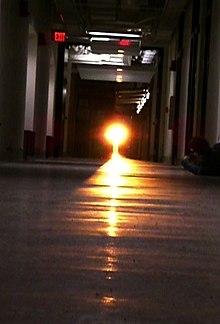Infinite Corridor
This article needs additional citations for verification. (September 2008) |

The Infinite Corridor is the hallway, 251 meters (825 feet, 0.16 miles) long, that runs through the main buildings of the Massachusetts Institute of Technology, specifically parts of the buildings numbered 7, 3, 10, 4, and 8 (from west to east). The corridor is important not only because it links those buildings, but also because it serves as the most direct indoor route between the east and west ends of the campus. The corridor was designed as the central spine of the original set of MIT buildings designed by William W. Bosworth in 1913. [1] "Traffic" in the corridor can be quite heavy at times, and in fact several "hacks" (modifications) have involved placing traffic signals, lane markings, and highway-like signs along its length.
Location
The steps to Lobby 7 from Massachusetts Avenue are the main entrance from the dorms, buses and fraternities on west campus and the Back Bay. Food vendors often park by the entrance. Lobby 7 is often used for concerts. During the 1970s, the pillars were used by the liberal Alternative Advertising and somewhat less liberal Pillar Productions where students would scrawl responses to issues of the day such as nuclear power or whether disco sucked. A display of Air Force art was once withdrawn after vandalism in the lobby. Banners are also often hung from Lobby 7, including the occasional hack such as "don't let the Grinch steal your Christmas" in reference to the common complaints about the campus Christmas tree.
Decorations
The corridor is decorated with many bulletin boards and display cases which have been remarkably unchanged over the years, though some such as the GAMIT board have been periodically vandalized over the years. The cashier office wall was painted as a giant dollar bill. The center of the corridor, known as "Lobby 10" (underneath the Great Dome, in building 10), features walls on which are engraved the names of MIT alumni who died in each of several wars. In Lobby 10, it is quite common to find several booths with students advertising upcoming events and activities, selling used books or Chinese pastries.
Different floors
The Infinite Corridor has five floors. The first floor is the most traveled level, and is often the only one referred to as the Infinite Corridor. It is half a floor above ground level at Massachusetts Avenue (the west end), and in areas is a full floor up, with a parking lot entrance passing underneath (this entrance crosses the basement-level corridor at grade). At its east end it is also about half a floor up, with nearby stairs going up to the second floor and down to the first floor of adjacent, newer buildings, which were built with lower ceilings.
MIThenge

On several days each year, the sun sets in alignment with the Infinite Corridor and shines along its entire length. This is known as "MIThenge", a reference to Stonehenge's alignment with the sun (although the type of alignment bears a closer relationship with that of Newgrange and Maeshowe in that the shining of the sun passing into the buildings body rather than through the standing stones of Stonehenge). These occur on several days around January 31 and November 11. The MIThenge site has more information about this phenomenon, as well as about the Infinite Corridor in general, although it should be noted that this page is no longer maintained and uses older, incorrect figures for the azimuth of the corridor.
Demonstrations
During the 1960s, a common Technology Day demonstration used the unobstructed length of the corridor to demonstrate the speed of light in a simple, direct way. A strobe light, photocell, and oscilloscope were positioned at one end of the corridor, and a mirror at the other. The round-trip time was about two microseconds. The photocell picked up both the direct and reflected flashes. The flash duration being well under a microsecond, the result was two nicely separated pulses on the oscilloscope screen.
References
- ^ Mark Jarzombek, Designing MIT: Bosworth's New Tech, Northeastern University Press, 2004.
External links
- MIThenge and photo
- Alan Eliasen has lots of information about MITHenge solar and lunar events and predictions for future dates.
